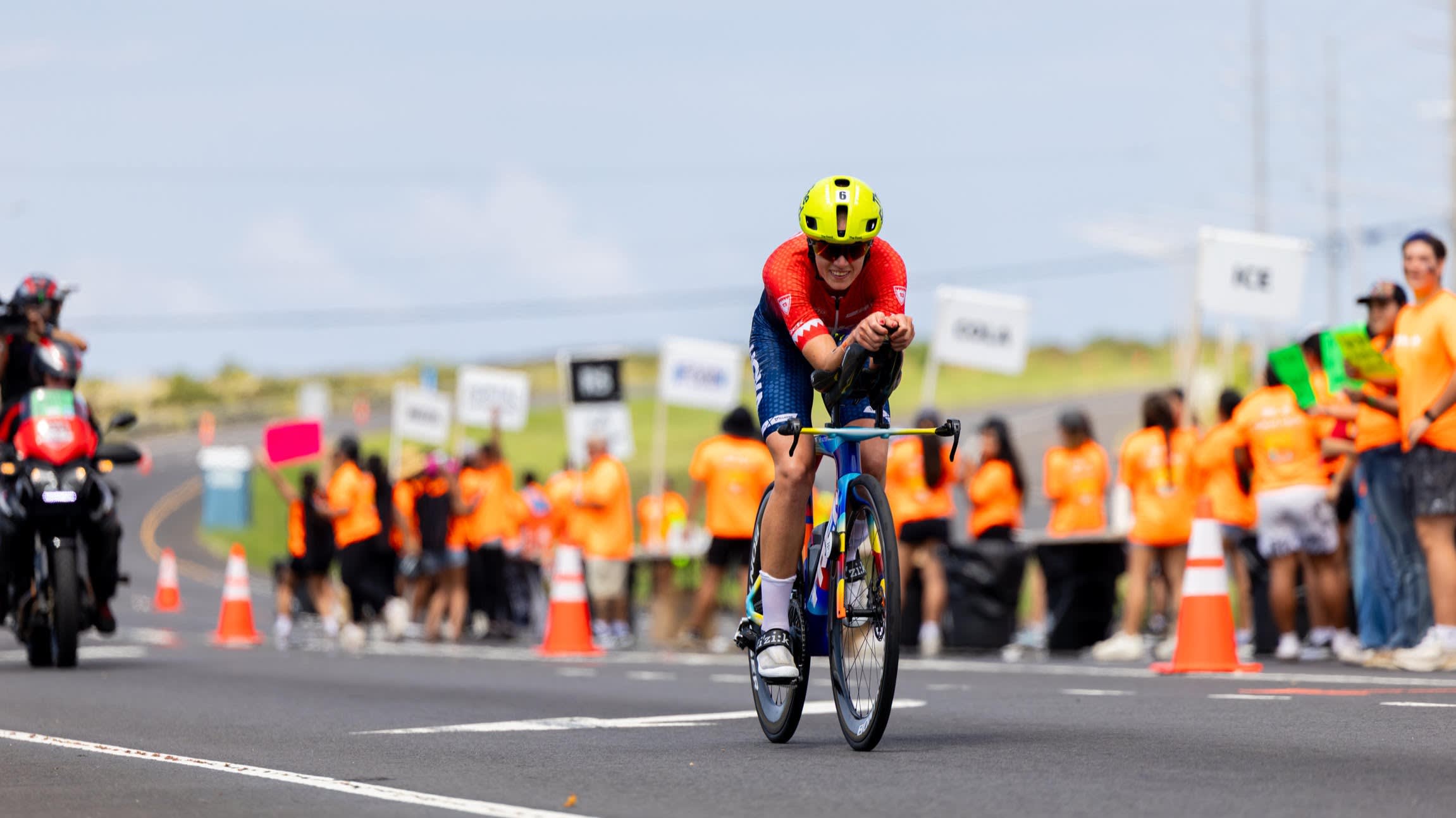
For nearly eight hours, Taylor Knibb had raced on the edge of perfection — until everything changed. This is the story behind Knibb's 2025 IRONMAN World Championship.
By Talbot Cox / The Feed
The road shimmered on the Queen K Highway, the air thick and unrelenting. Taylor Knibb had almost crested the final rise toward Palani, just two kilometers from the finish line of The IRONMAN World Championship. She ran straight through an aid station—and then suddenly stopped moving.
For nearly eight hours she had raced on the edge of perfection. Early on, Lucy Charles-Barclay controlled the day, leading the swim and the first half of the bike. But before the climb to Hawi, Knibb’s strategy—and her science—took over. Constantly checking her CORE Body Temperature Sensor displayed on her Garmin, she saw her internal heat creeping toward danger. “I had a maximum core temperature,” she said. “I was 0.1 degrees Celsius below that limit coming out of the water. So I had to chill on the bike for the first 90 minutes until I cooled down enough to really start racing.”
Once her temperature dropped 0.4 °C, she finally opened up. As the wind pushed across the lava fields, Knibb began to reel in Charles-Barclay. By Hawi she caught her, and on the descent they rode together, trading the lead in the gusts. When Knibb hit transition, she held a two-minute lead on Charles-Barclay and six minutes on Norway’s Solveig Løvseth.
Chasing the Helicopter
In the Knibb family there’s a saying: chase the helicopter. It’s the one that hovers above the race leader in Kona—the place every athlete dreams of.
Taylor first watched it at age 12 in 2010, standing beside her mom & dad on Ali‘i Drive. “When you go there, you definitely want to race it,” she said. “How many people in the world have ever led that race? That’s pretty cool.”
Fifteen years later, Knibb returned as one of triathlon’s most complete athletes—an Olympic medalist and three-time Ironman 70.3 World Champion. Training under coach Dan Lorang, she entered race week quietly confident. Friends joked that when Taylor goes silent on social media, it means she’s flying. “I make people uncomfortable when I go quiet,” she laughed. “It usually means I’m happy and training is going really well.”
The Warning Signs
The night before the race, Knibb couldn’t sleep. “I was just so hot,” she said. “I was putting ice on myself to fall asleep.” Her CORE Sensor data showed she was already overheating, but she shrugged it off. “Dan told me once the race started, I’d be fine,” she said. “That was not how it went.”
By the third stroke of the swim she felt awful but stayed patient, exiting the water within reach. On the bike she focused on the numbers—power, heart rate, body temp—knowing the island punishes impatience. After cooling down, she attacked the climb to Hawi, then descended alongside Charles-Barclay into Kona.
Running Her Race
By six kilometers into the marathon, Charles-Barclay caught Knibb and surged ahead. Most would have cracked. Knibb didn’t. “I just kept my rhythm,” she said. “I was going to run my pace and see where the cards fell.”
Then she noticed something—a change in Lucy’s routine. “She’d been jogging every aid station,” Knibb said. “Then suddenly she walked one. That’s when you know something’s off.” Within minutes Knibb was back alongside her.
When Knibb left the Energy Lab, the crowd thought the race was over. She looked strong, smooth, unbreakable. The commentators said it out loud: Taylor Knibb has Kona won.
But deep down, she knew the heat was stalking her. At one aid station she slowed and told herself: You are not getting second. You will die trying to win. Second wasn’t an option.


The Collapse
With the top of Palani nearly in sight—the final climb before the short downhill to the famous finish on Ali‘i Drive—Knibb’s body finally gave out. She stepped off course and sat down on the shoulder of the road.
From the finish line, thousands of spectators gasped. The roar of the crowd fell silent as word spread: the leader had stopped. Around the world, fans watching online couldn’t believe what they were seeing. After leading for so long, the race’s brightest star was down.
Knibb told her team she was done—she couldn’t finish. Moments later, medics rushed in. She was lifted into an ambulance and taken to the medical tent. There, doctors ran her labs: electrolytes, glucose, sodium—all perfect. They checked her core sensor again: 104.2 °F, a full 30 minutes after she’d stopped. By definition, a heat stroke.
After the Finish Line
When the noise faded, Knibb didn’t see defeat; she saw clarity. “If you told me I could either win Kona or keep my career, I’d choose my career every time,” she said. “That day just confirmed how much I love what I do.”
She’s already focused on 2026—what she calls her bonus year. The women’s championship was originally scheduled to return to Nice, France, but Ironman reversed course, bringing it back to Kona. “We get a bonus year,” she said. “It’s less than 50 weeks away. Time to get ready.”
Knibb’s takeaway from Kona can’t be measured by finish lines. “I didn’t think I was tough enough,” she said. “But I found out I can literally push myself to the edge. That’s kind of cool.”
Fueling Taylor’s Kona
Everything Taylor Knibb used to power 8 hours on triathlon’s toughest stage.
Taylor Knibb’s race in Kona didn’t end because of nutrition. Her fueling was flawless—something confirmed later in the medical tent, where doctors told her every lab number looked perfect: glucose, sodium, and electrolytes all right on target.
Knibb followed a data-driven plan built entirely around The Feed’s products and her own physiology. Here’s how she fueled the day:
Breakfast (3 hrs before start)
100 g cooked white rice
Pre-Swim (15 min before start)
1 × 750 ml bottle of Skratch Labs Superfuel Drink Mix with 100 g carbohydrates + 1,500 mg sodium → Blended with Skratch Labs Hydration Booster to match blood salinity for faster absorption
Bike – 112 miles
7 bottles total → 5.5 liters of fluid → 540 g carbohydrates → 4,800 mg sodium
Mostly Skratch Labs Superfuel, with two bottles of Skratch Labs Drink Mix (Lemon Lime) for variety
Run – 26.2 miles
4 bottles of 500 ml each → 30 g carbohydrates + 400 mg sodium per bottle
All liquid fuel—no gels—to avoid gut stress in the heat
Totals
≈ 6,300 mg sodium
≈ 640 g carbohydrates
≈ 6 liters fluid
Thirty minutes after collapsing, Knibb’s core-temperature reading still showed 104.2 °F, but her fueling numbers were textbook perfect. “It’s comforting,” she said. “It means I did everything right that I could control.”
Knibb plans to use the same fueling framework next season, fine-tuning for Kona’s heat and humidity—but not changing what worked. “Fueling wasn’t the problem,” she said. “The island was.”
